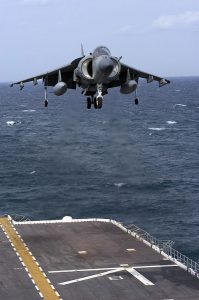The United States turned 240 years old this year. If you think about where we were in terms of transportation at the dawn of our nation, compared to the technological advancements we have experienced just since 2000, the tantalizing possibilities of the future of air travel are mind boggling.
According to Boeing Senior Technical Fellows Brian Tillotson and Kevin Bowcutt, space travel and hypersonics will be at the forefront of aviation innovation. Boeing, which is celebrating its centennial this year, talked with Travel + Leisure about its dreams and goals. Some of these may come to fruition as early as 2035.

The Harrier Jump Jet, one of the most famous and successful fixed-wing single-engine VTOL aircraft. It can take off and land in areas without a long runway.
- Tillotson speculates air travel will begin at home with the plane coming to pick you up at your residence, and takeoff and landing will most likely be vertical.
- You may be able to book a flight simply by thinking about it. This may seem far fetched, but with advancements in mobile devices and wearable technology, it may end up looking, according to Bowcutt, like an evolved version of Uber.
- Tillotson forecasts that airport security will be the product of many linked networks, allowing law enforcement to more easily identify those with criminal histories.
- Planes may be transparent, according to Tillotson, in order to help maintenance crews identify problems more quickly. It’s also possible, with this kind of construction, that every surface could double as a display screen, allowing for efficient troubleshooting.
- Airplanes will become smarter, according to Bowcutt, utilizing software that will alert maintenance personnel when a part is wearing out so that mechanical delays become a thing of the past. This should improve safety and reduce costs.
- Turbulence will be eliminated through the ability to see air patterns up to 100 miles ahead in a flight plan. Tillotson also explained that Boeing already has features in its 787 that dampen turbulence and reduce air sickness.
- Bowcutt predicts that in 100 years, we’ll be traveling at mach 5. Aerion is on the cusp of debuting planes that will travel at mach 1.4, which would shave six hours off trans-Pacific flight times.
- Vertical lift will make it possible to fly into remote places, like Mount Everest or the jungle, that aren’t accessible by plane now. Tillotson says this is almost a reality.
- Space flight will become a reality. “Since the 1980s, the U.S. has been developing technology to enable sustained hypersonic flight,” Bowcutt explained. This, he said, could lead to a situation where you would take one plane to low earth orbit and the other to the moon or Mars.
What are your predictions? What do you think the future of air travel will be in the next 25, 50, or 100 years? Share your ideas with us in the comments below, on our Facebook page, or in our Twitter stream.
Photo credit: U.S. Navy (Wikimedia Commons, Public Domain)
